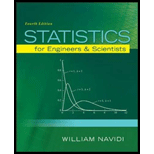
Concept explainers
a.
Find the value of
a.
Answer to Problem 18E
The value of
Explanation of Solution
Given info:
The mean decay rate of radioactive mass is at least 1 particle per second. If the mean decay rate is less than 1 per second, then the product will return for a refund. The number of decay events counted in 10 seconds is denoted as X.
Calculation:
The random variable X is defined as the number of decay events counted in 10 seconds. The X follows Poisson with mean,
The Poisson distribution formula is,
Where, x is a non-negative integer,
The required probability is
Substitute x as 0, 1,
Thus, the required probability is,
b.
Check whether one
b.
Answer to Problem 18E
Yes, one event in 10 seconds be an unusually small number.
Explanation of Solution
Justification:
From part (a), the value of
Thus, the one event in 10 seconds is an unusually small number.
c.
Explain whether counted one decay event in 10 seconds would be convincing evidence that the product should be returned or not.
c.
Answer to Problem 18E
Yes. Since one event in 10 seconds is an unusually small number.
Explanation of Solution
Justification:
From part (b), it clear that one event in 10 seconds is an unusually small number. Thus, it can be concluded that one decay event in 10 seconds would be convincing evidence that the product should be returned.
d.
Find the value of
d.
Answer to Problem 18E
The value of
Explanation of Solution
Calculation:
The random variable X is defined as the number of decay events counted in 10 seconds. The X follows Poisson with mean,
The required probability is
Substitute x as 0, 1,
Thus, the required probability is,
e.
Check whether 8 events in 10 seconds be an unusually small number, if the mean decay rate is 1 particle per second.
e.
Answer to Problem 18E
No. Since about
Explanation of Solution
Justification:
From part (d), the value of
Thus, the 8 events in 10 seconds is not an unusually small number.
f.
Explain whether counted 8 decay events in 10 seconds would be convincing evidence that the product should be returned or not.
f.
Answer to Problem 18E
No. Since 8 events in 10 seconds is not an unusually small number.
Explanation of Solution
Justification:
From part (e), it clear that 8 events in 10 seconds is not an unusually small number. Thus it can be concluded that 8 decay events in 10 seconds would not be convincing evidence that the product should be returned.
Want to see more full solutions like this?
Chapter 4 Solutions
Statistics for Engineers and Scientists
- A company found that the daily sales revenue of its flagship product follows a normal distribution with a mean of $4500 and a standard deviation of $450. The company defines a "high-sales day" that is, any day with sales exceeding $4800. please provide a step by step on how to get the answers in excel Q: What percentage of days can the company expect to have "high-sales days" or sales greater than $4800? Q: What is the sales revenue threshold for the bottom 10% of days? (please note that 10% refers to the probability/area under bell curve towards the lower tail of bell curve) Provide answers in the yellow cellsarrow_forwardFind the critical value for a left-tailed test using the F distribution with a 0.025, degrees of freedom in the numerator=12, and degrees of freedom in the denominator = 50. A portion of the table of critical values of the F-distribution is provided. Click the icon to view the partial table of critical values of the F-distribution. What is the critical value? (Round to two decimal places as needed.)arrow_forwardA retail store manager claims that the average daily sales of the store are $1,500. You aim to test whether the actual average daily sales differ significantly from this claimed value. You can provide your answer by inserting a text box and the answer must include: Null hypothesis, Alternative hypothesis, Show answer (output table/summary table), and Conclusion based on the P value. Showing the calculation is a must. If calculation is missing,so please provide a step by step on the answers Numerical answers in the yellow cellsarrow_forward
- Algebra & Trigonometry with Analytic GeometryAlgebraISBN:9781133382119Author:SwokowskiPublisher:Cengage
 College AlgebraAlgebraISBN:9781305115545Author:James Stewart, Lothar Redlin, Saleem WatsonPublisher:Cengage Learning
College AlgebraAlgebraISBN:9781305115545Author:James Stewart, Lothar Redlin, Saleem WatsonPublisher:Cengage Learning Glencoe Algebra 1, Student Edition, 9780079039897...AlgebraISBN:9780079039897Author:CarterPublisher:McGraw Hill
Glencoe Algebra 1, Student Edition, 9780079039897...AlgebraISBN:9780079039897Author:CarterPublisher:McGraw Hill  Trigonometry (MindTap Course List)TrigonometryISBN:9781337278461Author:Ron LarsonPublisher:Cengage Learning
Trigonometry (MindTap Course List)TrigonometryISBN:9781337278461Author:Ron LarsonPublisher:Cengage Learning
 Trigonometry (MindTap Course List)TrigonometryISBN:9781305652224Author:Charles P. McKeague, Mark D. TurnerPublisher:Cengage Learning
Trigonometry (MindTap Course List)TrigonometryISBN:9781305652224Author:Charles P. McKeague, Mark D. TurnerPublisher:Cengage Learning





